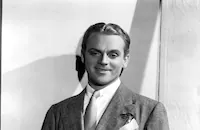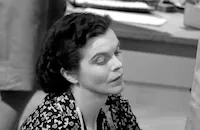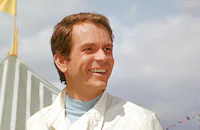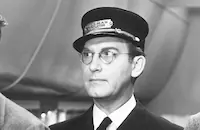These Wilder Years

Brief Synopsis
Cast & Crew
Roy Rowland
James Cagney
Barbara Stanwyck
Walter Pidgeon
Betty Lou Keim
Don Dubbins
Film Details
Technical Specs

Synopsis
At his steel company in Detroit, tycoon Steve Bradford informs his board that he will be away indefinitely on personal business. On the plane to the small town of Bufton, where he grew up, Steve notes the despair of a college football player who has just lost the big game, and urges him to remember his wins rather than what he has lost. At the Bufton orphanage, called The Haven, Steve reveals to proprietress Ann Dempster that he is searching for the son he abandoned as an infant twenty years earlier. When Ann questions why he wants to know his son after all this time, Steve confesses that he has everything in life: success, money, prestige. But he still feels empty, and wants to make up for his past mistakes. Ann explains that adoption law precludes her from giving away the young man's information, after which Steve informs her that he always gets what he wants.
They are interrupted when a couple comes to pick up their adoptive baby, the sight of which causes pregnant teenager Suzie Keller to burst into tears. Suzie is staying with Ann until the birth of her child, but cannot bear the thought of giving up the baby. Feeling a kinship with the confused youth, Steve consoles her, and later invites Ann to dinner, hoping to befriend her. Although Ann consents to Steve joining her and Suzie for dinner at their apartment, she is called away before he arrives. Suzie cooks for Steve and informs him that after her boyfriend was drafted, she had to leave town in order to avoid disgracing her parents, who are wealthy socialites. When Ann returns later, Steve serves her dinner, and Ann counsels Steve that, because his son already has a life and parents he loves, Steve's intrusion into their lives could be cruel. Although Steve tries to tempt her into giving him information by offering to donate a much-needed new dormitory for the orphanage, Ann refuses.
The next day, Steve visits local lawyer Leland G. Spottsford to consult about his rights regarding his son, but upon finding the lawyer a fatuous braggart, orders expert attorney James Rayburn to come to Bufton to help him. While awaiting Jim's arrival, Steve attends the local court, having learned from Ann that Suzie's juvenile court hearing will take place that afternoon. In court, he hears the truth about Suzie's situation: her father disappeared when she was born, her mother is dead and the baby's father is falsely denying his paternity. The court allows Suzie to remain with Ann until the birth of the baby, as long as she promises to place it up for adoption. Later, Steve tracks down his son's mother, Emily, by contacting her high school alumni association, and upon learning that she lives in New Hampshire, flies there to speak to her. At her family store, however, he discovers that Emily died years earlier. Although Steve tries to charm information out of Martha, Emily's sister, Martha knows who he is and coldly notifies him that he should "leave well enough alone." Back in Bufton, he finds Jim, who informs him that with enough time and money, he can find a loophole in the adoption laws.
Later, Steve runs into Suzie while she is Christmas shopping, and walks her home. There, Suzie conspires with Steve to urge Ann to go out with him, and he accompanies her to a department store, where he buys expensive earrings for Suzie, then pretends they are trinkets. Back at the apartment, Steve and Ann begin to forge a friendship while discussing Ann's devotion to her job. Ann is advising Steve to think of his son rather than himself when Jim calls to inform Ann that she has been subpoenaed for fraud, and she angrily throws Steve out. The trial soon starts, in which Ann is accused of deceiving Steve by placing his son up for adoption without his consent. Although Steve knows the charge is false and that the ensuing publicity about his past actions will ruin his reputation, he believes the trial is his only chance to gain access to his son. As Ann steadfastly refuses to hand over documents, however, placing her in danger of being in contempt of court, Steve grows more miserable.
On the witness stand, Ann explains that if Steve is allowed to wreck his son's peace, adoptive parents and children everywhere will fear the same could happen to them. She asks for a continuance, and when she returns, reads from the stand a statement Steve made to child welfare services twenty years earlier, in which he denied paternity of Emily's child. Steve recognizes the same words used by Suzie's boyfriend, and is shamed into silence. After the judge dismisses the case, Ann informs Steve that Suzie has been hit by a car and is refusing a necessary operation for fear that it will harm her baby. Steve rushes to the hospital, where he confesses to the girl that he cannot afford to lose her because he is too lonely, and convinces her to have the operation. He waits all night until the doctor assures him that both Suzie and her newly born son are healthy.
Exhausted, Steve walks to a nearby bowling alley to relieve the tension. He is followed by a young man who begins playing alongside him, then reveals that he is Steve's son, Mark Nelson, and has followed the press coverage of the trial. They try talking at the hotel bar, but the noise level drives them out onto the street, where Steve tries to explain his desire to make up for wronging Mark and his longing to meet him. After describing his beloved adoptive father and admitting that he has followed Steve's career through the newspapers throughout his life, Mark states that although he planned to tell Steve he despised him, now that he has met him, his anger is fading. Mark tells his father, "I missed you, too," and refuses Steve's offer of help, stating that all he ever needed was this meeting. Steve, knowing Ann must have contacted Mark, goes to The Haven to thank her. After he insists on donating a huge sum of money to the orphanage, Ann gently suggests that he could help Suzie, too. Within weeks, Steve readies to return to Detroit, alongside his new adoptive daughter and grandson, Stevie.

Director

Roy Rowland
Cast

James Cagney

Barbara Stanwyck

Walter Pidgeon

Betty Lou Keim

Don Dubbins

Edward Andrews
Basil Ruysdael
Grandon Rhodes

Will Wright
Lewis Martin

Dorothy Adams

Dean Jones
Herb Vigran
Ruth Lee
Matt Moore
Jack Kenny
Harry Tyler
Luana Lee
William Forrest
John Maxwell

Emmett Vogan
Charles Evans
Tom Laughlin
Bob Alden
Michael Landon
Jimmy Ogg
Nesdon Booth
Ricky Mcgough
Louis Towers
Mary Alan Hokanson
Marc Platt
Mary Lawrence
Elizabeth Flournoy

Charles Herbert
Sid Tomack
Leon Tyler
Kathleen Mulqueen
Burt Mustin
Russell Simpson
Bruce Irwin
Russ Whitney
Charles Tannen
Billy Wayne
Lillian Powell
Audrey Swanson
Jimmy Hayes
Edna Holland
Ralph Neff
Lois Kimbrell
Frank Connor
Crew
Jeff Alexander
Preston Ames
Edward G. Boyle
Tommy Edwards
Frank Fenton
George J. Folsey
Cedric Gibbons
Sydney Guilaroff
Al Jennings
Ben Lewis
John Logan
Tom Mccarthy
Dr. Wesley C. Miller
Scott Perry
Helen Rose
Jules Schermer
William Tuttle
Ralph Wheelwright
Edwin B. Willis

Photo Collections
Film Details
Technical Specs

Articles
These Wilder Years
Actually, the two stars were slated to appear together during their Depression Era heyday, in her early vehicle Night Nurse (1931), but by the time production was to begin on that film, Cagney had shot to stardom with The Public Enemy (1931), and his relatively small role (as a brutal chauffeur) was given to another young actor, Clark Gable. More than 20 years later, the two finally got their chance, and enjoyed their time together tremendously, even treating the crew with an impromptu dance number from their days as hoofers in New York in the 1920s.
The story concerns Cagney's attempts, late in life, to locate the illegitimate son he fathered many years earlier and Stanwyck's determination to prevent the rich and powerful businessman from circumventing adoption laws and possibly ruining the life of his now grown son. Eventually, Cagney does meet his son, briefly, but turns his attention to helping a young woman who is about to become an unwed mother; Cagney and Stanwyck eventually reach a mutual respect and understanding that could possibly lead to love in the film's closing frames.
For its time, These Wilder Years was a standard soap opera and critics noted on its release that it was hampered by an uninspired script and direction. The latter was handled by Roy Rowland, who had directed Stanwyck earlier in the 3-D Western The Moonlighter (1953) and the thriller Witness to Murder (1954). Writer and occasional actor Frank Fenton also had a history with Stanwyck, scripting her period mystery The Man with a Cloak (1951) and appearing with her in the raucous murder mystery-comedy Lady of Burlesque (1943). Another veteran added his expertise behind the camera: 13-time Oscar®-nominated cinematographer George J. Folsey, who had previously photographed Stanwyck in The Man with a Cloak and Executive Suite (1954).
The younger generation was played by two relative newcomers whose promising work never led to major roles. As the "girl in trouble," Betty Lou Keim had previously appeared in television dramas and made her feature debut with These Wilder Years. She appeared in both films and TV for a brief period after this, including notable work in Vincente Minnelli's Some Came Running (1958). Then she retired shortly after marrying fellow adolescent actor Warren Berlinger in 1959. Don Dubbins (he plays the son, Mark) got his start with uncredited roles in From Here to Eternity (1953) and The Caine Mutiny (1954), as well as a handful of TV roles. James Cagney took an instant liking to his young co-star in These Wilder Years and cast him in an important role in his Western Tribute to a Bad Man (1956). Dubbins went on to appear in various TV series and occasional features until his death in 1991.
Had These Wilder Years proceeded as originally planned, Cagney and Stanwyck might never have worked together. Variously titled "All Our Yesterdays" and "Somewhere I'll Find Him" in preproduction, the picture was originally to have featured either Helen Hayes or Myrna Loy in the part of the adoption agency head. Debbie Reynolds and Susan Strasberg were also initially announced for the role that eventually went to Keim.
Director: Roy Rowland
Producer: Jules Schermer
Screenplay: Frank Fenton, story by Ralph Wheelwright
Cinematography: George J. Folsey
Editing: Ben Lewis
Art Direction: E. Preston Ames, Cedric Gibbons
Original Music: Jeff Alexander
Cast: James Cagney (Steve Bradford), Barbara Stanwyck (Ann Dempster), Walter Pidgeon (James Rayburn), Betty Lou Keim (Suzie), Don Dubbins (Mark).
BW-91m.
by Rob Nixon

These Wilder Years
Quotes
Trivia
Notes
The working titles of this film were Somewhere I'll Find Him, All Our Yesterdays and All Our Tomorrows. On January 31, 1955, a "Rambling Reporter" item in Hollywood Reporter noted that M-G-M wanted Susan Strasberg to play the role of "Suzie Keller." Hollywood Reporter announced on February 17, 1955 that the studio had purchased the story on 16 Feb, and that prior to that date, Helen Hayes and James Cagney had agreed to star. Hayes planned to give to proceeds from the role to the Mary MacArthur Polio Foundation, dedicated to her daughter. However, according to a March 14, 1955 Daily Variety announcement, Hayes never signed the contract and subsequently withdrew due to scheduling conflicts. Ralph Wheelwright, an M-G-M publicist, took temporary leave from his position in order to write the story, his first, for These Wilder Years, as noted in an March 11, 1955 Daily Variety article. In September 1955, Louella Parsons stated in her Los Angeles Examiner column that Debbie Reynolds had been cast as Suzie but, concerned about playing an unwed mother, planned to back out. Parsons suggested that actress Judy Jordon could step in for Reynolds.
According to a March 1956 Hollywood Reporter news item, some scenes were shot on location at the Kaiser Steel Mills in Fontana, CA. Although a Hollywood Reporter news item and production charts add Janet Lake and Don Burnett to the cast, their appearance in the final film has not been confirmed. Betty Lou Keim, Tom Laughlin and Michael Landon (1936-1991) made their feature film debuts in These Wilder Years. Landon appeared in several films in the late 1950s, then went on to co-star in the popular television series Bonanza and Little House on the Prairie.

Miscellaneous Notes
Released in United States Summer August 1956
Released in United States Summer August 1956















